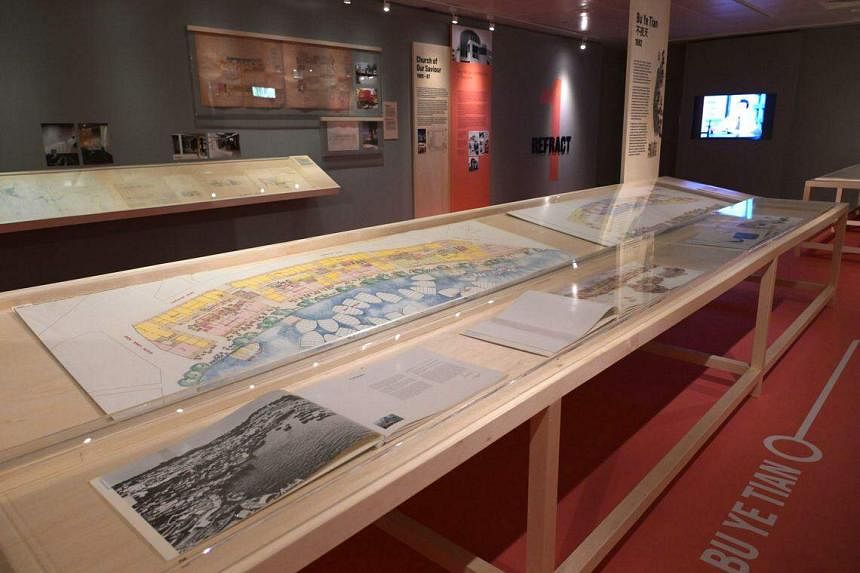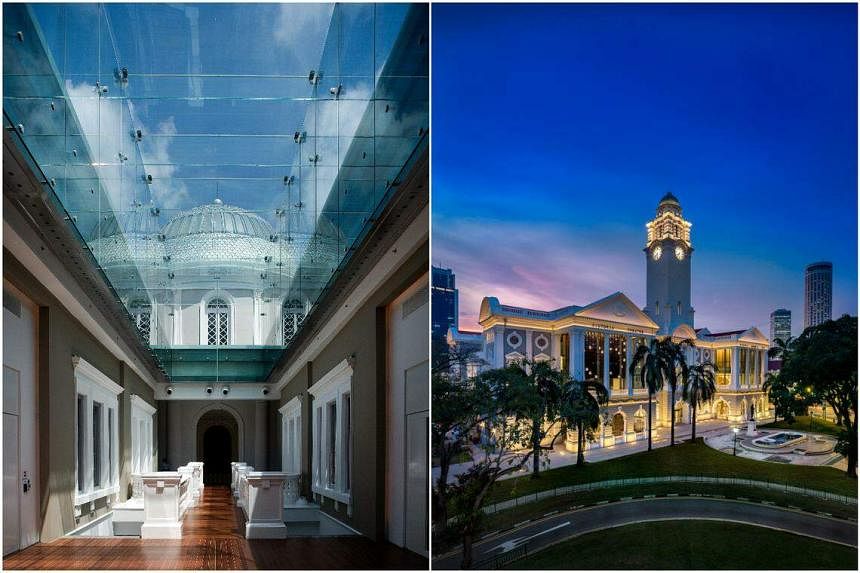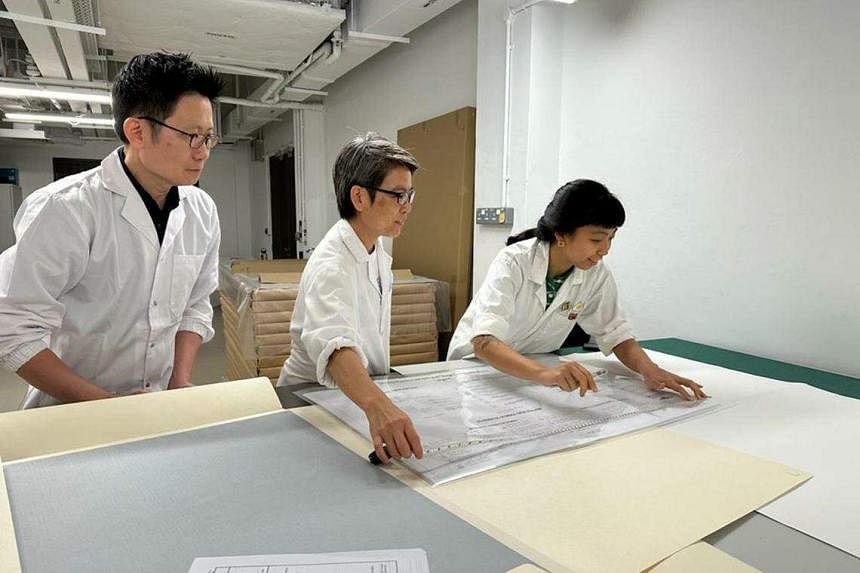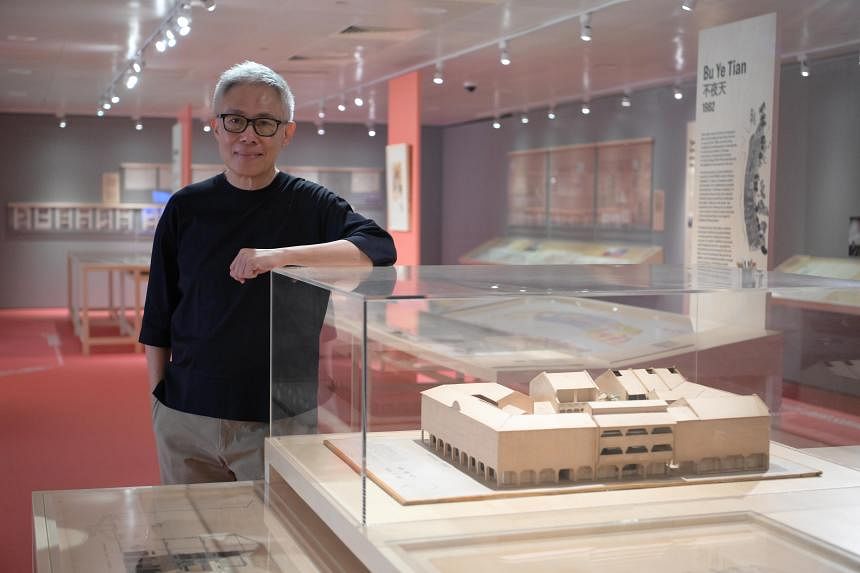SINGAPORE – From the conservation of pre-war shophouses to the designing of pivotal buildings, William Lim Associates and W Architects played a key role for more than 40 years in shaping the built environment of Singapore.
The significance of their contributions is seen in an exhibition, To Draw An Idea: Retracing The Designs Of William Lim Associates – W Architects.
Launched at The URA Centre in Maxwell Road on Nov 28, it narrates the firm’s creative arc from the post-modern oeuvre of late pioneer architect William S.W. Lim in the 1980s to the contemporary architecture of Mr Mok Wei Wei from the 1990s till today. The exhibition ends on June 8.
Piecing together the Singapore story
“In the early 1980s, there was no systematic effort to archive works, and many significant drawings, such as those for the conservation initiative Bu Ye Tian, went missing,” Mr Mok, W Architects’ managing director, tells The Straits Times.
He joined William Lim Associates in 1982 – the year Mr Lim founded the firm – shortly after graduating from the School of Architecture at the National University of Singapore (NUS).
Bu Ye Tian, a Mandarin expression referring to “a place of ceaseless activity”, was a proposal to transform 110 ageing colonial-era shophouses as part of the rejuvenation of the Singapore River into a lifestyle hub.

William Lim Associates was Mr Lim’s third architectural practice, after Malayan Architects Co-Partnership in 1960 and Design Partnership (later renamed DP Architects) in 1967.
At Design Partnership, he worked with teams to design People’s Park Complex and Golden Mile Complex, both completed in the early 1970s.
William Lim Associates was renamed W Architects after Mr Lim’s retirement in 2003.
Mr Mok, 67, says: “Since the 1990s, when I began running the firm, I started reminding architects to file their drawings. Even at that time, I envisioned that some day, these sketches and drafts would make a great archive to illustrate the larger Singapore architecture story.”
To Draw An Idea is the first major exhibition of the Singapore Architecture Collection (SAC), which was launched on Aug 21.
This collection aims to deepen efforts to document and preserve materials on Singapore’s modern and contemporary architecture – and capture the nation’s architectural heritage – through definitive works of individuals and teams.
The bulk of the collection – which is managed by the National Library Board, Urban Redevelopment Authority and National Heritage Board – will be held at the National Library Building in Victoria Street.
Mr Mok donated a few thousand items to this collection, in batches from 40 projects, starting from July 2019. To Draw An Idea showcases 19 of these projects, comprising more than 500 artefacts in a variety of mediums including hand sketches, computer-aided drawings and architectural models.
Ms Yap Lay Bee, URA’s group director of architecture and urban design, says the exhibition allows people to better understand Singapore’s architectural identity. It will also inspire architects to continue building Singapore into a greater city.
“The many drawings, sketches and models from the collection reveal detailed insights into our architects’ and designers’ visions, design processes, the challenges that they had to overcome and innovative solutions they developed,” she says.
She adds that the public can look forward to more showcases in 2024 and 2025, comprising donated materials from the collection.
“These are rich resources that can inspire the industry and future generations as they shape current and future designs of buildings and spaces. Over time, the collection can potentially be used for education and support deeper research on Singapore architecture.”
Cultural capital
The exhibition at The URA Centre is curated by independent architect Ronald Lim, who says To Draw An Idea is a valuable initiative.
“In many cities, including Singapore, the majority of buildings are often treated as real estate instead of cultural artefacts that can become landmarks,” the 42-year-old adds.
Mr Lim notes that as a format, the curated architectural exhibition, especially the kind that critically frames new design narratives, does not happen often enough in Singapore. As a young nation, recent architecture is also an important part of the Singapore story, he believes.
“Our buildings are part of our culture, just like art, literature and film,” he adds.
“Such exhibitions allow us to appraise and understand our architecture so that, hopefully, the best among these buildings can escape demolition because they are more broadly appreciated.”

Refract, Respond and Reflect
The exhibition is conceived in three parts: Refract, Respond and Reflect.
Refract revisits the works of William Lim Associates, such as Bu Ye Tian.
Details of the ground-up effort, spearheaded by the late entrepreneur and writer Goh Poh Seng in collaboration with Mr William Lim, are captured in the exhibition through sketches and a watercolour painting by artist Ong Kim Seng. Although the idea was presented to the Government in November 1982, it never saw the light of day.
But seven years later, the 110 shophouses were protected as one of the nation’s first 10 conservation enclaves.
The section also features buildings done in the post-modern style, which Mr Lim had started, such as Tampines North Community Centre.
Characterised by exuberant expressions, post-modern architecture was conceived as a counterpoint to the commercialisation seen in modernist architecture of the 1950s and 1960s, which resulted in buildings devoid of character.
The second part of the exhibition, Respond, and the final Reflect section chronicle the firm’s move away from the post-modern era, which petered out around the end of the 1980s.
The 1990s provided Mr Mok with the impetus to explore his love of contemporary architecture in the form of Light Construction.
Light Construction was the title of a ground-breaking exhibition in New York in 1995, showcasing the works of 30 architects from 10 countries at the Museum of Modern Art.
It was a sign of the times, when architecture shed the weight of heavy construction featuring concrete, popular in the post-war modern brutalist era (1950s to 1960s), and the ornamentation prevalent in post-modernism (1970s to 1980s).

Around that time, Mr Mok debuted his take on lightness in architecture, such as his 1996 design for an ultra-modern condominium project, The Paterson Edge, in which he unveiled Singapore’s first rooftop infinity pool.
Featured in the section Respond, this and other residential projects reveal the interactions between city planners’ many guidelines and the creative responses to them by local architects.
“There are many intangible layers in the design of a project which we have tried to show through our curation of artefacts,” says Mr Mok, referring to factors that bear upon a project, such as the social backdrop at the time, the architect’s vision and working within constraints.
Although Mr Mok moved away from post-modern architecture stylistically, his love of heritage buildings remains. This is seen in the final section, Reflect, with projects such as the refurbishment of the National Museum of Singapore in 2002 and the Victoria Theatre and Victoria Concert Hall in 2009.

Reflecting to forge ahead
Mr Mok says he wanted to use the word Reflect because it is also important for busy creatives to pause and take stock.
“Churning out creative output day in and day out can be draining,” he observes. “It is a fundamental part of the design process to reflect on past work to find out what drives the creative impulse.”
He says he has been able to sustain his creativity through the back-cataloguing of his projects, as it allows him to reflect on a common thread that links them.
“Through reflection, I have found that my architectural perspective is rooted in dualism, which is about finding equilibrium in a state of tension created by two contrasting or even contradicting elements.
“That comes with archiving, which is my contribution to our shared knowledge of Singapore architecture.”
Architect and design educator Adrian Lai, who visited the exhibition twice in December and spent more than two hours there each time, says To Draw An Idea is “timely as well as extraordinary” in showcasing years of commitment and curiosity.
“In a city composed almost entirely of buildings, the exhibition reminds us of the talent, ideas and ways of working that define architecture,” says the 48-year-old, who is principal architect at home-grown firm Meta Architecture. He is also adjunct assistant professor for architecture at NUS.
“For generations of architects, William Lim Associates and W Architects epitomised what design excellence means in building and urban design, and this exhibition gives a rare glimpse of the rigour and vigour on the drawing boards before an architect creates meaningful impact in a city and in people’s lives.”
To Draw An Idea: Retracing The Designs Of William Lim Associates – W Architects
Where: The URA Centre, 45 Maxwell Road
When: Till June 8; Mondays to Saturdays, 9am to 5pm; closed on Sundays
Info: str.sg/pfMY
Labour of love by the National Library Board
It takes months of painstaking work to prepare an artefact such as a sketch, drawing or photograph to be presented in an exhibition, says the National Library Board (NLB).
It received a few thousand documents for more than 40 projects for the showcase To Draw An Idea: Retracing The Designs Of William Lim Associates – W Architects, donated by Mr Mok Wei Wei, managing director of W Architects, between 2019 and 2023. Of the 40 projects, 19 are now presented in the exhibition at The URA Centre in Maxwell Road.
Ms Alicia Yeo, director of the National Library, says the meticulous conservation work is not only labour-intensive, involving a team of experienced conservators, but also “truly a labour of love”.
First, every piece is fumigated to get rid of pests and indexed to build an inventory of the artefacts.
Repairs are then carried out on damaged pieces and “housing” is created for the items. This entails removing staples, stitching or tying groups of papers together, using archiving sheets that protect the documents. The pieces are subsequently boxed.

Some items are also digitised to prevent loss from decay.
The items are then sent to the Lee Kong Chian Reference Library at the National Library Building in Victoria Street for the public to access. All artefacts, including those not selected to be shown at The URA Centre, will be made accessible to researchers at the reference library.
The reference library is the premier resource for works on or about Singapore and the region. It occupies seven floors at the National Library, with a floor area of more than 14,000 sq m.
Ms Yeo says the cataloguing process is time-intensive and requires subject knowledge from the cataloguers and librarians.
“The librarians who oversee the collection work closely with the different departments within NLB – such as the processing unit, preservation and conservation, and cataloguer – throughout every single stage of the donation process.”
She says cataloguers spent months working on the collection for To Draw An Idea. The shortlisted artefacts also required special expertise from the team to allow the public to search for the materials through NLB’s online catalogue at str.sg/zcsK
“Through the archive, we’ve gained insights into our rich Singapore stories, through the evolution of the country’s architectural heritage,” she adds.
“To Draw An Idea allows us to delve into the imagination of architects and designers, their design processes, the challenges they had to overcome and the many innovative solutions they developed.
“Much of the architecture within the collection has acquired historical, cultural and social significance over time.”


